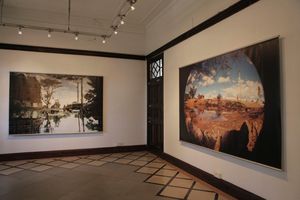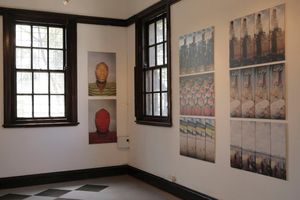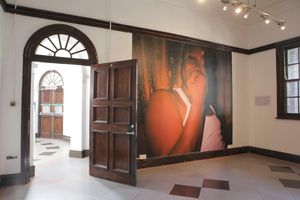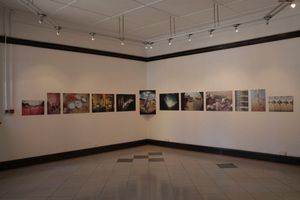Grassroots Upgraded
2011
Grassroots Upgraded_01_Image_2011_Slum TV_(c)Anne Nyokabi-6
Lomo Photography In Mathare: “you Think You Know.” - Wambui Mwangi
Originally published in Slum TV, Grassroots Upgraded. Brüssels: Stichting Kunstboek, 2011
Prologue:
Lomo Photography in Mathare: “You Think You Know.”
Strictly speaking, one never understands anything from a photograph. --Susan Sontag, On Photography.
Be fast. --Lomo Photography Rule #7
I sit at my desk to prepare for this essay, about to partake of an act of looking with my fellow Nairobi denizens, the Lomo Mathare photographers. In the middle-class enclave where bougainvillea and a green quiet shelter my writing space, I open my laptop. I see the valley of my wrist as it rests on the keypad, the knob of bone, tendons running up the slope to knuckles. My back hunches, head lowers; fingers curve and land. I dock, mind to eyes to screen to pixels to cyberspace to pixels to film to the hands of another, holding a prosthetic seeing device. I am prolonged, enhanced.
- The Lomo Mathare images are a heterogenous romp: a pair of shoes on a rooftop; a radio balanced on a rock; a man cutting into a rubber tyre, face shadowed by the brim of his hat; a stool and a stove side by side in sublime proportions and the physical relatedness of a long-married couple; the corner of a barber shop; a figure on a roof, in silhouette, leaning forward on one knee; a chicken staring at another chicken staring at its image in a mirror propped against a wall; a man turning chapatis on a skillet like a hip-hop DJ in ‘the zone’; the reflection of a building in a pool of water, sharper and more vivid than the building itself; fragments, glimpses, arrested moments of neighbours, children, dogs, work, play, food, laundry, shadows, blurred motions, doors opening into mysteries, merriment and melancholia.
2.Lomo Photography has 10 Golden Rules. Rule #10: Don’t Worry About Any Rules.
- Lomo Mathare is an ecstasy of image-making and an intentionally political act. With Wim Wenders: “the most political decision you can make is where you direct people’s eyes.”
4.A powerful and pervasive NGO aesthetic currently rules the global imaginary about Mathare.
Emaciated, unschooled and unshod Abandoned, naked and unvaccinated, Female genital mutilated, overworked,
My image is engraved in your mind
And in the minds of the world’s children.
After all this is Africa—
a rich source of unreal stories since the beginning of time.
Phyllis Muthoni, “Face of Africa” Lilac Uprising
The Lomo Mathare photographs posit irruptions, interruptions and ruptures against this visual hegemony.
- And ethically?
So you should simply make the instant Stand out, without in the process hiding What you are making it stand out from

Grassroots Upgraded_01_Image_2011_Slum TV_(c)Anne Nyokabi-6
- Let us stage an encounter of support:
Brecht, cited by John Berger in About Looking
[T]hey are not inventing new fictions and mythologies. Rather, they are formulating new visions of the African present in all its heterogeneity of meaning and multiplicity: with neither heroes nor villains. The African worldview presented in this crop of images is not total. Neither is it always explicitly referential. These are pictures, to be sure, but also systems of meaning, ways of confounding and interrogating historical certitudes of the truth of the photographic mark, and of the exhibition’s principal subject: the African postcolonial condition.
Okwui Enwezor, Snap Judgements.
Enwezor speaks of other African artists, not the Lomo Mathare photographers. All the better: this is African consensus in theory and praxis.
- I sit back in my chair, pleased with my suturing.
A niggling thought intrudes. I look again.
Poised against the poverty of the NGO imagination, the Lomo Mathare images are abundant, refutations of lack, even though sometimes they are images of it. Images can say more than one thing at a time.
- The photographers Enwezor writes about in Snap Judgements differ from the Lomo Mathare artists: they are more formally analytical, more self-consciously didactic and dialectical, more aware of our global eyes and international theoretical quarrels about “the gaze.”
In contrast, Lomo Mathare photographers do not feel like returning veterans of the Representational Wars. They are too—free.
Yet the Lomo Mathare photographers also understand their work as a counter-measure to the dominant aesthetic and NGO narrative of “suffering children, thin men and burdened women”:
--David Mbuthia Mwangi wants “to educate a global audience”
--James Otieno wants to “show the bigger picture in the slum”
--Esther Waweru thinks “there are sides to Mathare even she hasn’t seen”
---Simon Gachugo wants “to prove to people outside Mathare how people in the slums live . . . to prove that people in Mathare are not idle”
--Ian Mwangi claims “the responsibility of the photographer is to show creativity in the slum”
- Each of the photographers above agreed with the counter-hegemonic mission, but each also gave at least three unique reasons or motivations for their photography.
The fissures multiply.
- With Mitchell: What do[ these] pictures want?
I check myself for wounds from the punctum. No bleeding yet. Perhaps a thousand indiscernible paper cuts?
- I look out at the view framed by the rectangle of my window and think of the distance between me and Mathare. Only the banal would measure it in terms of spatial distance. I look back again, for the twentieth or thirtieth time, at the Lomo Mathare images, floating on my screen, able to float to the screens of others, migrate to Germany, Brazil, Swaziland. Mombasa, Kisumu, Nairobi. Printed in books, bought, sold, passed on. On the move, circulated, by the self-same structures of the globalised system, by the societies of spectacle and economies of desire.

Grassroots Upgraded_01_Image_2011_Slum TV_(c)David Mbuthia-1
- Through photographs, the world becomes a series of unrelated, free-standing particles; and history, past and present, a set of anecdotes and faits divers. The camera makes reality atomic, manageable and opaque. It is a view of the world which denies interconnectedness, continuity, but which confers on each moment the character of a mystery.
Susan Sontag, On Photography
- Texts tell the truth like this: “I always lie.”
Photographs tell lies like this: “I always show the truth.”
We know to query texts, but we think images are a literal window on the reality just outside. Yet, images multiply the unseen along with visible, the way in which garrulity generates silences along its edges and within its crevices.
- Look again.
No, that’s not outside your window.
Only those who can “appreciate and read the photograph in a context which is continuous with that from which the camera removed” it –Berger’s admonition--can “see” the picture, or refrain from its violence.
Listen to Sontag again: It is a view of the world which denies interconnectedness, continuity, but which confers on each moment the character of a mystery.
Pay more attention to the dissidence of excess, the willed, the bubbling ‘suffocation of images’ from Lomo Mathare.
- Lomo Mathare Text: Although the so-called 'international community' is an audience for the images that Slum TV produces, the primary audience is the local one. Seeing oneself perpetually represented as being in need has a deep impact on self-confidence, self-imaginary and self- consciousness. Slum TV is trying to interrupt this process.
- no continuity is to be assumed between (a) what makes power possible and (b) the kinds of possibilities that power assumes. . . . Assuming power is not a straightforward task of taking power from one place, transferring it intact, and then and there making it one’s own; the act of appropriation may involve an alternation of power such that the power assumed or appropriated works against the power that made that assumption possible.
--Judith Butler, Psychic Life of Power.
- They know you.
‘A set of anecdotes, fait divers;’ enough to make you think you know them. A visibility that increases the unseen.
- Avert your eyes
You think you know me
You look at me and say ‘you poor
thing’, turn and walk away
What do you know of my pain,
my joys, my hurt, my pride, my passion?
I am here, pity me, love me, hate
me,
I am here, and just maybe the
Joke’s on you!
Nyambura Githongo, You Think You Know, Koroga.
- What do these images want?
The punctum.
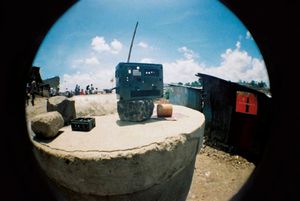
Grassroots Upgraded_01_Image_2011_Slum TV_(c)David Mbuthia-2
Epilogue. I close my laptop and get up from my chair. I stretch sore muscles, cramped limbs. I leave my house and walk out onto a Nairobi street. My lungs fill with air. “I become a butterfly. Emerge from my chrysalis into a brand new day!”
--Sitawa Namwalie, Scent of Moonflower, Koroga.
...Meno kama dirisha wazi....
Binyavanga Wainaina, Facebook.(1)
--
- [My trans]. “..teeth like an open window...”
Wambui Mwangi October 2010 Nairobi.
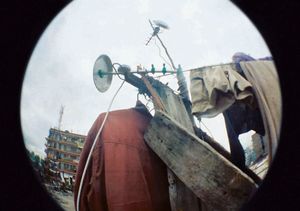
Grassroots Upgraded_01_Image_2011_Slum TV_(c)Ephantus Kariuki-6
References.
Berger, John. 1991. About Looking. Vintage International, New York.
Butler, Judith. 1997. The Psychic Life of Power. Stanford UP, Stanford.
Enwezor, Okwui. 2006. Snap Judgements. New Positions in Contemporary African Photography. International Center of Photography & Steidl. New York.
Githongo,Nyambura.2010.“YouThinkYouKnow.” Koroga.
http://madkenyanwoman.blogspot.com/search?q=You+think+you+know
Lomo Photography. “The Ten Golden Rules—Lomography.”
http://www.lomography.com/about/the-ten-golden-rules
Mitchell, W.J.T. 1994. Picture Theory. Chicago UP. Chicago.
Mitchell, W.J.T. 2005. What Do Pictures Want? Chicago UP. Chicago.
Muthoni, Phyllis. 2010. “Faces of Africa.” Lilac Uprising: Poems for the City and Other Places. Phyllis Muthoni, Nairobi.
Namwalie, Sitawa. 2010. “Scent of Moonflower,” Koroga.
http://madkenyanwoman.blogspot.com/2010/09/koroga-scent-of-moon-flower-sitawa.html
Ranciere, Jacques. 2008. The Politics of Aesthetics. Continuum, New York.
Slum TV 2010. “Lomo Bios.doc” [courtesy Sam Hopkins]. Lomo Mathare, Nairobi.Slum TV 2010. “Lomo Photography in Mathare.” [image collection]. Lomo Mathare, Nairobi. Slum TV. 2010. “Intro_Lomo.doc” [courtesy Sam Hopkins]. Lomo Mathare. Nairobi.
Sontag, Susan. 2008. On Photography. Penguin Books, New York.
Wainaina, Binyavanga. 2010. Facebook. “Comment.” http://www.facebook.com/#!/photo.php? fbid=394105645937&set=a.394104460937.175399.506480937
download text as PDF